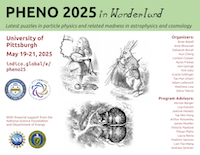Conveners
Astro-particle: Axion, Black Holes
- Carlos Blanco (Pennsylvania State University)
Astro-particle: Neutrinos, Cosmic Rays
- Dibya Sankar Chattopadhyay (Oklahoma State University)
I'll discuss the conversion of relativistic axion dark radiation into terahertz electromagnetic radiation via a novel resonance that is only accessible in a neutron star magnetosphere thanks to the strong magnetic field. Based on 2408.04551 with Enrico Schiappacasse.
I will discuss the blue loop stage of intermediate mass stars as a type of ``magnifying glass'', where even seemingly small effects in prior stages of evolution, as well as assumptions about stellar composition, rotation, and convection, produce discernible changes. As such, blue loops, and especially the existence and properties of Cepheids, can serve as a laboratory where feebly connected...
Some of the most stringent constraints on axions arise from considerations of it's emission from astrophysical plasmas. However, many studies assume that particle production occurs in an isotropic plasma environment. This condition is rarely (if ever) met in astrophysical settings, for instance due to the ubiquitous presence of magnetic fields. The effects of the magnetic fields are only taken...
Stellar binaries have historically provided a rich target in the search for exotic compact objects such as primordial black holes (PBHs) or MACHOs. In a three-body interaction involving a PBH and a binary star system, the binary can either lose or gain a significant amount of energy from the PBH, leading to a change in its orbital period. A standard lore has been that if the perturber velocity...
How the supermassive black holes form has been an enduring puzzle. Recent discoveries of active galactic nuclei near cosmic dawn by James Webb Space Telescope suggests that SMBHs may have formed as early as $z ∼ 10$. We propose a mechanism that SMBHs form naturally near the cosmic dawn if the dark matter is axion or ALPs. Axion dark matter thermalizes by gravitational self-interactions and...
The observation of an exploding black hole would provide the first direct evidence of primordial black holes, the first direct evidence of Hawking radiation, and definitive information on the particles present in nature. However, indirect constraints suggest that direct observation of an exploding Schwarzschild black hole is implausible. We introduce a dark-QED toy model consisting of a dark...
We explore a conformal dark matter model based on the gauge group $SU(N_{c}) \times U(1)_{D}$, from which we can obtain confinement of bound-state dark matter at a dark QCD scale, and a WIMP and self-interacting dark matter at a higher energy scale, around $1$ TeV, along with the possibility of gravitational wave (GW) production from strong first-order phase transitions at both scales. We...
We predict the expected flux of anti-electron flavor neutrinos in the diffuse supernova neutrino background (DSNB) with the inclusion of both failed and successful supernovae and binary stellar systems. Using simulations from the Garching Core-collapse Supernova Archive of single star progenitors and their neutrino energy spectra for a variety of explosion models, we determine an optimal...
In the coming age of precision neutrino physics, neutrinos from the Sun become robust probes of the conditions of the solar core. Here, we focus on $^8$B neutrinos, for which there are already high precision measurements by the Sudbury Neutrino Observatory and Super-Kamiokande. Using only basic physical principles and straightforward statistical tools, we calculate projected constraints on the...
We investigate the potential of evaporating primordial black holes (PBHs) as unique astrophysical sources of high-energy neutrinos originating from the decays of heavy beyond-Standard-Model (BSM) scalars. In their final stages, PBHs can attain temperatures sufficient to emit CP-even (H2), CP-odd (𝐴), and charged Higgs bosons (𝐻±). In specific regions of parameter space, 𝐻2 and A predominantly...
Neutrinos produced by interactions between ultra-high-energy (UHE) cosmic rays and the cosmic microwave background can help trace the origins of these particles and investigate the mechanisms driving their extreme acceleration.
The detection of neutrinos above the PeV scale requires instruments capable of monitoring several cubic kilometers of dense material, as the neutrino flux drops...
We propose a novel method to study the ultra-light bosons, where compact rotating objects undergo the phenomenon of quenched superradiance to create gravitational waves and neutrino flux signals. The neutrino flux results from appropriate coupling between the ultra-light bosons and the neutrinos. We consider a heavy sterile neutrino generation from ultralight scalar, which later results in...
The growth of large-scale structure in the early universe remains unexplained to this day. Originally proposed by Alan Guth, inflation, which posits a brief period of rapid cosmological growth, stands as a potential explanation to this puzzle. Inflationary models use “slow roll parameters” to align predictions with cosmological constraints fixed by data from the CMB and other such experiments....

